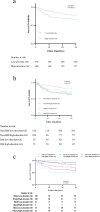The glycemic gap as a prognostic indicator in cardiogenic shock: a retrospective cohort study
- PMID: 39223451
- PMCID: PMC11368036
- DOI: 10.1186/s12872-024-04138-w
The glycemic gap as a prognostic indicator in cardiogenic shock: a retrospective cohort study
Abstract
Background: Stress-induced hyperglycemia (SIH) is associated with poor outcomes in cardiogenic shock (CS), and there have been inconsistent results among patients with or without diabetes mellitus (DM). The glycemic gap (GG) is derived by subtracting A1c-derived average glucose from blood glucose levels; it is a superior indicator of SIH. We aimed to explore the role of GG in the outcomes of patients with CS.
Methods: Data on patients diagnosed with CS were extracted from the MIMIC-IV v2.0 database to investigate the relationship between GG and 30-day mortality (Number of absolute GG subjects = 359; Number of relative GG subjects = 357). CS patients from the Second Affiliated Hospital of Wenzhou Medical University were enrolled to explore the correlation between GG and lactic acid (Number of absolute GG subjects = 252; Number of relative GG subjects = 251). Multivariate analysis, propensity score-matched (PSM) analysis, inverse probability treatment weighting (IPTW), and Pearson correlation analysis were applied.
Results: Absolute GG was associated with 30-day all-cause mortality in CS patients (HRadjusted: 1.779 95% CI: 1.137-2.783; HRPSM: 1.954 95% CI: 1.186-3.220; HRIPTW: 1.634 95% CI: 1.213-2.202). The higher the absolute GG level, the higher the lactic acid level (βadjusted: 1.448 95% CI: 0.474-2.423). A similar trend existed in relative GG (HRadjusted: 1.562 95% CI: 1.003-2.432; HRPSM: 1.790 95% CI: 1.127-2.845; HRIPTW: 1.740 95% CI: 1.287-2.352; βadjusted:1.294 95% CI: 0.369-2.219). Subgroup analysis showed that the relationship existed irrespective of DM. The area under the curve of GG combined with the Glasgow Coma Scale (GCS) for 30-day all-cause mortality was higher than that of GCS (absolute GG: 0.689 vs. 0.637; relative GG: 0.688 vs. 0.633). GG was positively related to the triglyceride-glucose index. Kaplan-Meier curves revealed that groups of higher GG with DM had the worst outcomes. The outcomes differed among races and GG levels (all P < 0.05).
Conclusions: Among patients with CS, absolute and relative GGs were associated with increased 30-day all-cause mortality, regardless of DM. The relationship was stable after multivariate Cox regression analysis, PSM, and IPTW analysis. Furthermore, they reflect the severity of CS to some extent. Hyperlactatemia and insulin resistance may underlie the relationship between stress-induced hyperglycemia and poor outcomes in CS patients. They both improve the predictive efficacy of the GCS.
Keywords: Cardiogenic shock; Glycemic gap; Inverse probability treatment weighting; Prognosis; Propensity score-matched analysis.
© 2024. The Author(s).
Conflict of interest statement
The authors declare no competing interests.
Figures





References
-
- Helgestad O, Josiassen J, Hassager C, Jensen L, Holmvang L, Sørensen A, et al. Temporal trends in incidence and patient characteristics in cardiogenic shock following acute myocardial infarction from 2010 to 2017: a Danish cohort study. Eur J Heart Fail. 2019;21(11):1370–8. 10.1002/ejhf.1566 - DOI - PubMed
Publication types
MeSH terms
Substances
LinkOut - more resources
Full Text Sources
Medical
Miscellaneous

